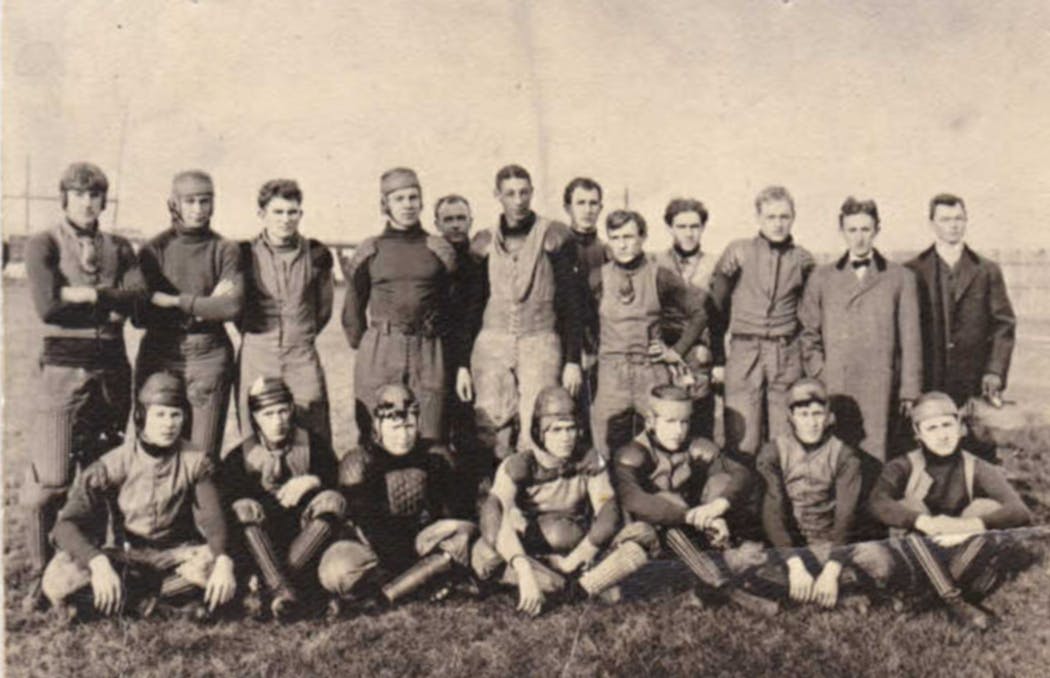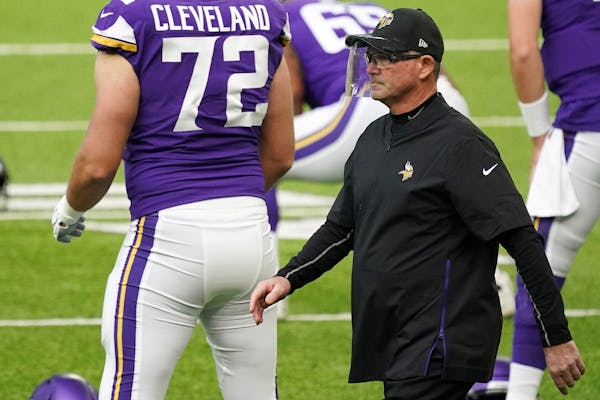Odds are Bobby Marshall is the greatest football player, the most distinguished Minnesotan and the most multifaceted Black pioneer you've never heard of.
As the first full century of NFL games officially faded into the history books this past week, today's players look forward to a future in which their voices can impact social justice. But it's also important, leaders say, to look back and honor the backs upon which today's opportunities were built.
"It's amazing to me what those guys went through to give us the opportunities we have today," said Vikings co-defensive coordinator Andre Patterson, a 60-year-old Black man. "I don't know if I could have done it."
Born the grandson of Virginia slaves on March 12, 1880, Marshall was 40 years old, a Minneapolis lawyer and the state's grain commissioner when one of his part-time gigs as a three-sport legend in football, baseball and hockey led him to becoming the first person of color to play a game in the American Professional Football Association, which was later renamed the National Football League.
On Sept. 26, 1920, two weeks before Pro Football Hall of Famer and celebrated Black pioneer Fritz Pollard made his debut with the Akron Pros, the 6-2, 195-pound Marshall hopped a southbound train and played both ways at end as his Rock Island (Ill.) Independents blanked the visiting St. Paul Ideals, an independent pro team, 48-0 in the first game played in league history. On Oct. 3, Marshall's Independents beat the Muncie Flyers 45-0 in one of the first two games between APFA teams.
Marshall and Pollard were the league's only Black players that year. Eleven more would play between 1921 and 1933 before an unwritten rule among owners — veiled as a "gentleman's agreement" — kept Black players out of the league until 1946.
"I give all those guys equal credit because 1920 was a time when racial unrest in this country was worse than it is today," said Joe Horrigan, retired Pro Football Hall of Fame executive director and the foremost historian of the game.
The country was a tinderbox of tension as it recovered from the Spanish flu pandemic of 1918 and the end of World War I. Black workers were migrating from the South in search of better jobs and more racial equality for their contributions to the war efforts. And Black men were being lynched, including three in Duluth on June 15, 1920.
Marshall and Pollard became targets of racism from fans and opposing teams. Pollard would dress in the Akron owner's nearby cigar store and often be driven by car to midfield moments before kickoff to avoid bottles being thrown at him.
"On the field, Fritz once told me that his trick was to roll over onto his back as soon as he was tackled," Horrigan said. "That way his cleats were pointing up and he could literally kick guys away as they were coming to pile on."
Fighting ignorance
Marshall was born in Milwaukee, the son of Richard, a Black man working as a blacksmith's apprentice, and Symanthia Gillespie, a Black woman of German-Jewish heritage whose father, Ezekiel, was a former slave who became a civil rights pioneer and won a landmark court case securing voting rights in Wisconsin. The family moved to Minneapolis, where Bobby was a multisport athlete at Central High School, graduating in 1901.
Marshall was the first Black athlete at the University of Minnesota, playing multiple sports and becoming one of the greatest football players in school history. He made the College Football Hall of Fame posthumously in 1971. In 1999, the Star Tribune ranked him 51st in its Top 100 most influential Minnesotans — and the state's 10th-greatest football player — of the 20th century.
Marshall also is believed to be the first Black person to:
• Graduate from Minnesota's law school.
• Be appointed to the state grain department, where he worked for 39 years.
• Play professional hockey, his favorite sport, in the U.S. when he signed with an independent team in Pennsylvania.
• Serve as an assistant coach for Gophers football and the Western Conference, which became the Big Ten.
Yet because he was Black and Jewish, Marshall couldn't live in the dorms on campus.
Because he was Black, an opposing team from New Prague ordered him to leave the field before a local club pro game in 1907. New Prague wasn't going to play unless Marshall left. Marshall refused and the game was played.
And because he was Black, Marshall was attacked by two Ironwood, Mich., players while playing for a club team from Hibbing in 1923.
"It happened right in the middle of the game," said Terry McConnell, whose book "Breaking Through the Line: The NFL's First African-American, Minnesota's Bobby Marshall" is due out next spring.
"Marshall, of course, was able to defend himself rather easily. He was a boxer, a wrestler, a phenomenal athlete."
Marshall was known for a calm, thoughtful demeanor. He wasn't easily ruffled. Not even on the day as a Gophers assistant when he saw how popular the Ku Klux Klan had become in Minnesota.
"The KKK had a float in the homecoming parade one year," said Bill Marshall, one of Bobby's 11 grandchildren. "But my grandfather always carried himself as a complete gentleman. He stressed education first. His general attitude was people respected you if you were educated.
"The racists, in his opinion, were unbelievably stupid. And since he made probably more money than 85 to 90 percent of the white people in this country at the time, who were they?"
NFL turns away Black players
Marshall died of Alzheimer's disease in 1958. He was 78.
By McConnell's count, Marshall played in 315 high school, college and professional football games, averaging nine a year for 35 years. He played football until he was 56, baseball until he was 60 and softball until 65.
Of those 315 games, only 12 were with teams that were in the NFL at the time. He played nine games for Rock Island in 1920 and three games with the Duluth Kelleys in 1925, when he was 45. He played for numerous independent town teams, such as the Minneapolis Deans and Minneapolis Marines, as well as several barnstorming All-Star teams.
By 1933, when Marshall was 53, the NFL was back down to two Black players — Ray Kemp of the first-year Pittsburgh Pirates and Joe Lillard of the Chicago Cardinals.
"The Pirates were in New York for a game against the Giants," Horrigan said. "The night before the game, the hotel manager calls [owner] Art Rooney over."
Kemp wasn't welcome. He would have to stay at a Black hotel.
"They call Ray over and Art tells him, 'Ray, if you want, we'll fight this,' " Horrigan said. "Ray said, 'No, I don't want to cause a problem.'
"Ray was up in his 80s when he told me, 'That walk from the front desk to the front door was the longest walk I ever took in my life.' "
That game against the Giants would be Kemp's last in the NFL. After just five games, he was out of the league at age 26 as the NFL joined Major League Baseball in excluding Black players.
"Ray said Art Rooney invited him to return in '34, but whether that's true or not, I don't know," Horrigan said. "But Ray had a chance to make more money in coaching and took it. As for Lillard, he was simply not invited back. And he was a very effective runner."
The so-called "gentleman's agreement" to exclude Black players was in place for the next 12 seasons.
Color barrier broken again
In 1946, a year before Jackie Robinson famously broke the color barrier in baseball, pro football had Marion Motley, Bill Willis, Kenny Washington and Woody Strode.
A new league — the All-America Football Conference — and a progressive and legendary coach named Paul Brown brought Willis and Motley, whom he had coached before, to Cleveland, where they became Hall of Famers like Brown.
Meanwhile, in Los Angeles, the Rams bucked the NFL's "gentleman's agreement" when pressured by the local government to integrate the roster or leave the municipally run L.A. Coliseum and find somewhere else to play.
"Paul made football decisions knowing the politics he was facing," Horrigan said. "The Rams weren't happy. They went after two guys from UCLA because they thought they could sell tickets. Woody was past his prime, and the saying goes that the Rams played him every down early hoping he would get tired and quit."
In one of the last interviews before his death in 1999, Motley talked at length about what he went through as a player and how critical it was that he and Willis not lose their cool.
"I'm sure that if Bill and I had been like some of the young kids today, we would have acted up," Motley said. "And we would have set Black players back another 20 years."
He then pulled out a letter he had saved for more than half a century. It was from Branch Rickey, the Brooklyn Dodgers' owner who signed Jackie Robinson. Rickey also owned a football team in the AAFC in 1946.
"It says, 'If Marion Motley and Bill Willis can break the color barrier in a contact sport, then Jackie Robinson can do it in a noncontact sport,' " Motley read out loud.
It wasn't easy.
"Look at my hands," said Motley, holding up a set of mangled digits.
"You would put your hand down to get up and someone would step on your fingers and twist his spikes into your hand on purpose. But the name calling might have been the worst."
Motley, a bruising fullback, led the AAFC in rushing in 1946 despite having to sit out a game in Miami.
"Bill and I got death threats before that game," Motley said. "I still remember reading that letter. It came to the Browns and was addressed to me. It said if the two of us played, they would kill us."
Brown had Motley and Willis stay home. The Browns won 34-0.
Appreciating barrier-breakers
Patterson, the Vikings' co-defensive coordinator, is a child of the '60s who was born in Arkansas and had family in Mississippi. But he grew up in California sheltered from a lot of what was taking place in the South.
"One summer, I visited Mississippi," Patterson said. "We go by this beautiful baseball field and I was like, 'I want to play baseball there.' And my family is like, 'No, you can't play there.'
"Then they point and say, 'Over there is your field.' And it doesn't even have dirt. It's just a grass field. I kept asking them why I couldn't play on the nice field. They didn't want to tell me until they finally had to for my own good."
Patterson admitted he had not heard of Bobby Marshall before being interviewed for this story. He made it a point to change that.
The Vikings have a Marshall display in the Early Football in Minnesota exhibit at the team museum in Eagan. They've acknowledged Marshall during their Celebrate Perseverance digital campaign during Black History Month. And they featured him in a gameday program as part of the NFL's 100th season last year.
The Pro Football Hall of Fame in Canton, Ohio, also has an exhibit on Marshall and the other early Black pioneers.
"It's important to learn the sacrifices these guys made," Patterson said. "For them to have the inner strength to go through all that, not say anything and still be able to go out on the field and be the best at what they do, that's just remarkable to me."
The Marshall family wants the NFL to do more to preserve and honor Bobby's legacy on and off the field. They're crafting a letter to the league in hopes they can get a scholarship to be endowed in his name after the Vikings named one for George Floyd, who was killed in police custody on Memorial Day.
"If they want a scholarship for social justice, they could easily put one in my grandfather's name," Bill Marshall said. "People today should know that my grandfather is one of the greatest Black Minnesotans in our state's history. Period."




